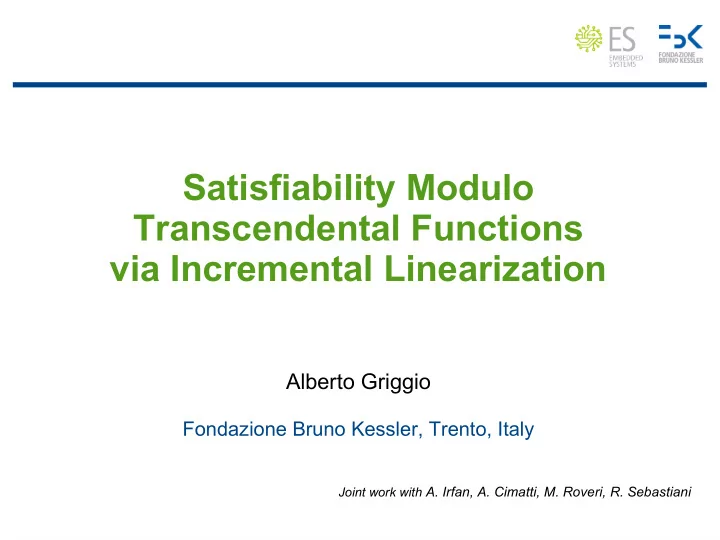

Satisfiability Modulo Transcendental Functions via Incremental Linearization Alberto Griggio Fondazione Bruno Kessler, Trento, Italy Joint work with A. Irfan, A. Cimatti, M. Roveri, R. Sebastiani
Executive Summary Main idea Abstract transcendental functions with uninterpreted functions Incrementally add upper- and lower- bound linear lemmas Tangent and secant lines Added to refine spurious models Challenges Irrational values: transcendental functions give irrational outputs to (most) rational inputs Linearization requires calculation of slope at arbitrary point, which is not straightforward Handling periodicity (of trigonometric functions) Detecting SAT
Some Math Background Transcendental function : doesn’t satisfy a polynomial equation We assume to be continuous and (n-times) differentiable Tangent line to at point : Secant line to between and : Concavity: sign of the second derivative Taylor theorem:
Main Algorithm initial abstraction precision return UNSAT return SAT
Initial Abstraction Replace every occurrence of a transcendental function with a corresponding uninterpreted function Add some basic lemmas about the behaviour of the function E.g. for exponential
Spuriousness Check Check that the model is consistent wrt Intuitively, check Problem: is typically irrational Can’t check precisely Solution: check whether is close enough to use Taylor’s theorem to compute polynomial bounds Depend on the current precision Model is definitely spurious if or
Spuriousness Check and Refinement while true : e := 10 -precision L := {}
Spuriousness Check and Refinement while true : e := 10 -precision L := {} for all tf(x) in : c := P l (x), P u (x) := poly-approx (tf(x),c,e) if or : L := L + get-lemmas-point (tf(x), ,P l (x),P u (x))
Spuriousness Check and Refinement while true : e := 10 -precision L := {} for all tf(x) in : c := P l (x), P u (x) := poly-approx (tf(x),c,e) if or : L := L + get-lemmas-point (tf(x), ,P l (x),P u (x)) if L is empty: if check-sat ( , ): return true else: precision += 1 else: return false , L
Refinement via Linearization – Basic Idea Use upper and lower polynomials for linearization If the concavity of the function is negative (positive): Tangent Refinement: Tangent Line to the upper (lower) polynomial gives upper (lower) bound Secant Refinement: Secant Line to the lower (upper) polynomial gives lower (upper) bound
Refinement via Linearization – Basic Idea Use upper and lower polynomials for linearization If the concavity of the function is negative (positive): Tangent Refinement: Tangent Line to the upper (lower) polynomial gives upper (lower) bound Secant Refinement: Secant Line to the lower (upper) polynomial gives lower (upper) bound Spurious Point
Refinement via Linearization – Basic Idea Use upper and lower polynomials for linearization If the concavity of the function is negative (positive): Tangent Refinement: Tangent Line to the upper (lower) polynomial gives upper (lower) bound Secant Refinement: Secant Line to the lower (upper) polynomial gives lower (upper) bound Tangent Refinement Spurious Point
Refinement via Linearization – Basic Idea Use upper and lower polynomials for linearization If the concavity of the function is negative (positive): Tangent Refinement: Tangent Line to the upper (lower) polynomial gives upper (lower) bound Secant Refinement: Secant Line to the lower (upper) polynomial gives lower (upper) bound Tangent Refinement Spurious Point Precision
Refinement via Linearization – Basic Idea Use upper and lower polynomials for linearization If the concavity of the function is negative (positive): Tangent Refinement: Tangent Line to the upper (lower) polynomial gives upper (lower) bound Secant Refinement: Secant Line to the lower (upper) polynomial gives lower (upper) bound Tangent Refinement Spurious Point Precision The concavity of the lower and upper polynomials should be equal to the concavity of the function in the interval of interest
Refinement: Exponential Function Using Taylor’s theorem : Case x = 0: Lower Polynomial: Upper Polynomial: Case x < 0: Lower Polynomial: when n is odd Upper Polynomial: when n is even Case x > 0: Lower Polynomial: Upper Polynomial:
Sin Function We introduce a symbolic variable with initial rational bounds Reasoning is split depending on two periods: Base Period: Extended Period: when not in the base period For each sin(x), new application sin(y x ) y x fresh (called a base variable) The domain of y x is in the base period sin(x) and sin(y x ) are equal in the base period
Sin Function Tangent and secant refinement only with base variables Concavity check in the base period is easy Case x > 0: concavity is negative Case x < 0: concavity is positive Using Taylor’s theorem and current precision Lower Polynomial: Upper Polynomial:
Sin Function – Extended periods Shift to the base period, and compare with Shift calculation If the values differ, we perform shift refinement Relate the extended period with the base period (after appropriate shift) Note that the shift is symbolic in Ensure soundness
Check for SAT We know so, is a candidate solution Sufficient condition for sat: validity of Replace ’s with fresh vars and check validity of the first-order formula
Implementation and Experiments Prototype Implementation in MathSAT + PySMT 887 BMC Benchmarks (also Tools MathSAT scaled) MetiTarski Hand-crafted benchmarks iSAT3 Discretized Hybrid System dReal benchmarks HyComp benchmarks iSAT benchmarks HyST benchmarks HARE benchmarks 681 MetiTarski Benchmarks (also scaled) 944 dReal Benchmarks
Results
Results
Thank You
Recommend
More recommend